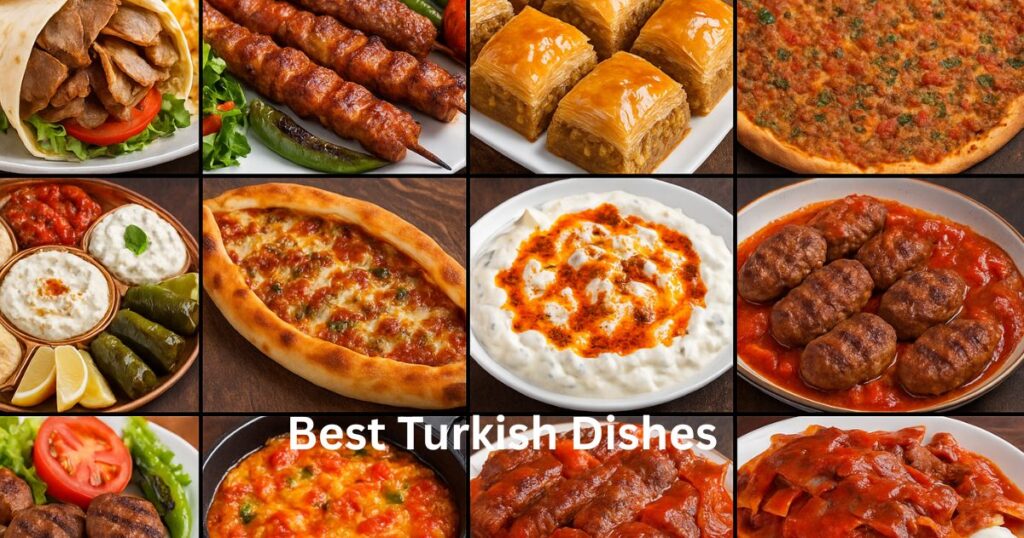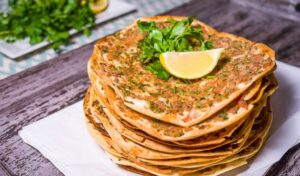Turkey’s food is a diverse blend of culture, history, and taste. These ten meals are important samples of Turkish cuisine, whether you’re dining in a traditional Anatolian house or exploring Istanbul’s bustling streets. Every meal, from spiced flatbreads and meze spreads to sizzling kebabs and fluffy pastries, reflects a distinct local tale and centuries of history. For tourists looking for a genuine Turkish culinary experience, this carefully chosen list features the most well-known and recognizable meals.
Here is a list of Ten Must-Try Turkish Dishes
- Doner Kebab (Döner Kebap)
- Kebabs (Shish Kebab / Adana / Urfa Kebap)
- Baklava
- Lahmacun
- Meze Platter
- Pide
- Manti
- Köfte (Turkish Meatballs)
- Menemen
- İskender Kebab
Doner Kebab (Döner Kebap)

Introduction
Doner Kebab is arguably the most iconic Turkish street food, enjoyed both within Turkey and around the world. It is usually served as a wrap, sandwich, or on a platter with sides and is made up of seasoned beef that is slowly roasted on a vertical rotisserie.
Historical Background
İskender Efendi is credited with creating döner kebab in Bursa, Turkey, in the 19th century. İskender created a dish that transformed fast food in Turkey and worldwide by adapting the horizontal spit-roasting techniques employed by nomadic Turks vertically for improved fat distribution and more effective roasting.
Description of the Dish
A vertical spit is used to hold marinated lamb, beef, or chicken pieces that are cooked by rotating in front of a heat source. They are eaten with sides like rice, salad, or flatbread after the outer layers are shaved off as they become crisp and brown.
How to Prepare the Dish
First, the meat is marinated for a few hours or overnight in a mixture of yogurt, herbs, garlic, and spices (such as paprika and cumin). After that, the slices are arranged in layers on a big skewer and compressed into a solid cone. The browned meat is shaved and served right away after being cooked on a vertical rotisserie.
Conclusion
Go to Bayramoğlu Döner in Istanbul or Kebapçı İskender in Bursa to enjoy real döner. In Turkey’s culinary scene, renowned chefs like Cüneyt Asan have contributed to preserving the quality and heritage of döner.
Kebabs (Shish, Adana, Urfa Kebap)

Introduction
Anywhere in Turkey, a kebab is different, but they all have one thing in common: meat that has been carefully seasoned and grilled to perfection. Kebabs are an important part of Turkish food, whether they are skewered (shish), hot (Adana), or mild (Urfa).
Historical Background
Kebabs come from the traditions of nomads in Central Asia. They were first made as a useful way to cook meat over open fires. Over many years, places like Adana and Şanlıurfa created their own unique spice mixes and cooking methods, which made kebab-making an important craft.
Tell me about the dish
You can use whole cuts of meat or ground meat (mostly lamb or beef) mixed with herbs and spices to make kebabs. Shish kebab is made of cubes of meat on skewers. Adana kebab is made of spicy ground meat shaped around flat metal skewers, and Urfa kebab is the mild form of Adana kebab.
How the dish was made
Garlic, onion, chili flakes (especially for Adana), paprika, and salt should be mixed with cubed or chopped meat before cooking. Grill the meat over coals until the outside is charred and the inside is still juicy. Buns, grilled veggies, and bulgur or rice on the side should go with this dish.
Conclusion
Some great places to visit are Zübeyir Ocakbaşı (Istanbul) and Ciğerci Usta (Adana). Kebabs have become more fancy thanks to chefs like Mehmet Gürs, but they still have a rural feel to them.
Baklava
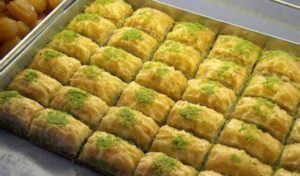
Introduction
Baklava is a rich and sweet dessert cake with flaky layers and a nutty filling that is all covered in a syrup that smells great. It’s a traditional holiday food and a sign of Turkish friendliness.
Historical Background
There are different ideas about where baklava came from in the Balkans and the Levant, but its modern form was perfected in the royal kitchens of the Ottoman Empire, especially at Topkapı Palace. Gaziantep, in the southeast of Turkey, is now its spiritual home and a UNESCO site for culinary history.
Tell me about the dish
Baklava is made of very thin yufka (filo) dough that is covered with melted butter and chopped nuts like pistachios or walnuts. It is then baked until it turns golden. As soon as it comes out of the oven, it’s soaked in sugar syrup that has lemon or rose water added to it.
How the dish was made
Put yufka sheets in a tray and brush each one with clarified butter. Spread a lot of ground nuts on top after a few layers, then add more dough layers. You can bake them until they are crisp and then pour them over cooled sauce. Give it time to soak in for hours.
Conclusion
If you want to taste real Turkish food in Gaziantep, try Koçak Baklava or Güllüoğlu. Master baklava chefs like Nadir Güllü keep the tradition alive with strict methods and a sense of pride in their area.
Lahmacun
Introduction
The thin, crispy flatbread called lahmacun is topped with a spicy minced meat blend. It is often called “Turkish pizza.” A popular street food that’s great for a quick and tasty meal.
Historical Background
Lahmacun is thought to have come from Mesopotamia. It comes from the Arabic term lahm bi-‘ajin, which means “meat with dough.” The Ottoman era saw a lot of it being cooked in Turkish homes, especially in places like Gaziantep and Urfa in the southeast.
Tell me about the dish
On top of a very thin circle of dough is chopped lamb or beef mixed with tomatoes, onions, parsley, and spices such as paprika and pul biber (chili flakes). The dough is then quickly baked at high heat.
How the dish was made
Get the dough ready and let it rise. Mix the topping ingredients until they are smooth enough to spread. Cut the dough into thin circles. Spread the meat mixture out evenly. Bake at a high temperature for a few minutes, or until the circles are golden. It goes well with onions, lemon, and parsley.
Conclusion
If you want the best lahmacun, go to Borsam Taşfırın Lahmacun in Kadıköy, Istanbul. Try Şirvan Sofrasi in Gaziantep instead. It has traditional ovens and family recipes that are great.
Meze Platter
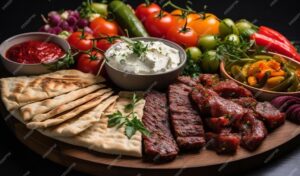
Introduction
A meze platter is a collection of small foods that are often shared as an appetizer or to go with bigger meals. It has the warm hospitality, friendly talk, and wide range of foods that are typical of Turkey.
Historical Background
You can trace the history of meze back to the Ottoman Empire and older Mediterranean cultures. Levantine, Greek, and Persian foods all had an impact on meze, which became an important part of rakı culture, which is when people get together in taverns to eat and drink small snacks.
Tell me about the dish
Along with creamy dips like haydari (garlic yogurt) and hummus, meze usually has hot ezme, vine leaf-wrapped dolma, and seafood like octopus salad. Each item has a different taste, texture, and color whether it is served cold or at room temperature.
How the Dish was Made
The dish is made one at a time. For example, haydari is made by mixing squeezed yogurt, garlic, and herbs; dolma is made by rolling grape leaves around rice and herbs; and ezme is made by chopping tomatoes, onions, and peppers very small. Artfully put together on a plate, they are ready to be shared.
Conclusion
If you want to try real meze, go to Asmalı Cavit in Istanbul or Kalamış Balıkçısı on the Bosphorus. In their menus and books, famous cooks like Musa Dağdeviren stress how regional meze is.
Pide

Introduction
Pide is a boat-shaped Turkish flatbread with savory fillings on top. It is often compared to pizza, but its taste, preparation, and appearance are all very Turkish. It’s a favorite dish for both everyday lunches and big parties.
Historical Background
Pide comes from the area around the Black Sea and has roots in traditional Turkish tandoori baking. Some regions had different ingredients, dough thicknesses, and baking styles, but it became popular during the Ottoman era and spread all over the world.
Tell me about the dish
The dough is stretched out into a long oval form, and the edges are folded in to make a pocket that can hold minced meat, Turkish sausage, cured beef, spinach, cheese, or an egg. In a stone oven, it’s cooked until crispy and crisp.
How the dish was made
Make soft dough and let it rise. Fold the sides in and brush them with egg yolk. Then roll it into an oval shape and spread the filling on it. Put it in a hot oven (stone or wood-fired is best) and bake it until it bubbles and starts to brown a bit.
Conclusion
If you want to see an original pide, go to Fatih Karadeniz Pidecisi in Istanbul or Niyazi Usta in Samsun. Boğaç Şimşek and other artisan cooks are bringing back old Black Sea styles with a modern twist.
Manti
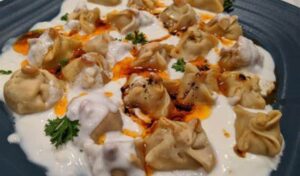
Introduction
You can eat manti, which are Turkish dumplings filled with spicy ground meat, with a tangy yogurt-garlic sauce or melted butter that has been mixed with paprika. It’s a comfort food that people in the area really love.
Historical Background
The manti is thought to have come to Anatolia with Central Asian Turkic groups and changed over many years. People all over the country became familiar with the version from Kayseri, where dumplings are known for being very small.
Tell me about the dish
Small balls of dough are pressed shut and filled with ground lamb or beef. They are then boiled or cooked. On top, there is garlic yogurt and hot butter. For a different look, sumac or mint is sometimes put on top.
How the dish was made
Make a simple dough and stretch it out. Place a meat mixture in the middle of each square, fold it over, and pinch it shut. Boil until soft. Put strained yogurt, garlic, and butter that has been mixed with pepper or chili on top.
Conclusion
To really feel like a manti, go to Kayseri Mantıcısı or Bodrum Manti in Istanbul. In recipes and on TV, chefs like Ayşe Tüter keep the traditional art of manti folding alive.
Köfte (Turkish Meatballs)
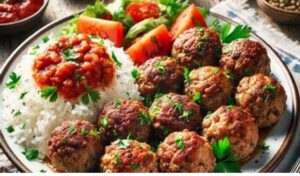
Introduction
Köfte are Turkish meatballs that are made from ground meat that has been spiced and shaped into logs or patties. They can be grilled or fried. They are a favorite in homes, bars, and even on the side of the road.
Historical Background
Köfte comes from Persian and Arab cooking styles and is now an important part of Turkish food. The İzmir köfte is spiced with a lot of cumin, while the southeastern Turkey çiğ köfte is made with just ground meat.
Tell me about the dish
Most of the time, onion, breadcrumbs, eggs, herbs, and spices are mixed with ground beef or lamb to make the base. Köfte are shaped and cooked until the outside is golden and the inside is juicy. They can be eaten with salad, rice, or inside bread.
How the dish was made
Finely chopped onion, breadcrumbs, and spices like cumin, paprika, and parsley should be mixed with ground meat. Make logs or patties out of the meat and grill or fry until golden. You can bake them with veggies if you want to make İzmir-style köfte.
Conclusion
Going to Tarihi Sultanahmet Köftecisi or Köfteci Arnavut for classic köfte is a good idea. Many generations of restaurants in Istanbul have learned how to make köfte from master chef Refik Usta.
Menemen
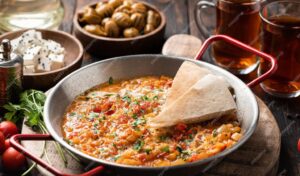
Introduction
A tasty Turkish breakfast meal called menemen is made by gently scrambling eggs, tomatoes, peppers, and sometimes onions together. People love it because it’s easy, quick, and tastes great. It’s often served with fresh bread for dipping.
Historical Background
This dish, which is named after the town of Menemen near İzmir, became famous in the early 1900s as a fresh, cheap, and healthy meal for farmers. It shows how agriculturally rich western Anatolia is and has something to do with Turkey’s strong breakfast culture.
Tell me about the dish
It’s a soft scramble of eggs and veggies that tastes a lot like stew. Green peppers and tomatoes are cooked in a pan, and eggs are cracked into the pan and tossed around a little. Depending on the person or the area, variations can include onions, cheese, or sucuk (Turkish sausage).
How the dish was made
In olive oil, cook chopped green peppers and onions, if you want to. Put in chopped or grated tomatoes and cook until they get soft. Add the eggs and stir them in slowly. Stir less for creamier eggs and more for harder ones. Add salt, pepper, and pul biber if you want.
Conclusion
You can enjoy traditional menemen at Lades Menemen in Istanbul or Sakızlı Kahvaltı Evi in İzmir. Turkish chefs like Refika Birgül love the food and talk about how versatile it is and how culturally warm it is in her cooking shows.
İskender Kebab
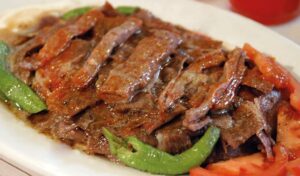
Introduction
Iskender Kebab is a royal dish made of thinly sliced döner meat stacked over pieces of pide bread, drenched in tomato sauce and melted butter that’s sizzling, and served with sour yogurt. This meal has deep roots in the area and is very rich and decadent.
Historical Background
İskender Efendi in Bursa created this dish in the late 1800s. He changed the way kebab was made by roasting meat upright and serving it with local bread and dairy. It quickly became a sign of Ottoman and Bursa food, and it’s still one of Turkey’s most famous kebabs.
Tell me about the dish
The dish is made up of thin, juicy lamb or beef döner served on top of small cubes of pide. It has a lot of hot, melted butter, spicy tomato sauce, and yogurt on top of it. It stands out because of how the textures and temperatures work together.
How the dish was made:
Grill or roast marinated meat on a vertical spit. Cube the pide bread and toast it. Make a sauce with tomatoes. Place bread, then meat, on a plate. Pour the sauce over top, and top with butter that is sizzling. Serve with yogurt. Garnishes like parsley or vinegar are optional.
Conclusion
For a unique taste, go to Kebapçı İskender in Bursa, where the dish is still made by the family of İskender Efendi. A descendant, Chef İskenderoğlu, makes sure that the original method and quality stay the same. For kebab lovers, it’s like going on a journey.
Final Thought
Turkey’s food is more than just food; it’s a cultural journey through flavors, customs, and hundreds of years of history. Every food, from the sizzling doner kebab to the delicate layers of baklava, has its own story that combines Middle Eastern traditions with local skills. You can discover Turkey’s real food history with every bite, whether you’re enjoying the strong spices of Adana kebab, the comforting warmth of menemen, or the buttery richness of İskender kebab.
Turkish food is more than just a way to satisfy your hunger. It’s a view into a way of life that values warm hospitality, eating with others, and using fresh, high-quality ingredients. In other words, if you go to Turkey, don’t just see the sights—taste the food! This lively food culture is ready to please your taste buds, with everything from busy street vendors to traditional family places

